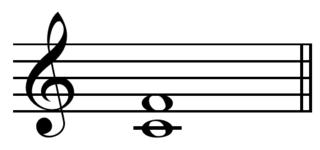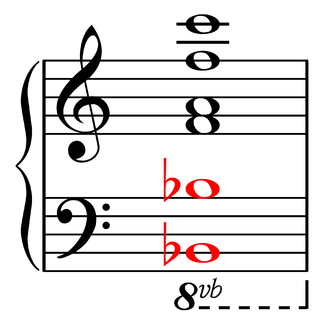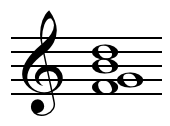
In music, counterpoint is the relationship between two or more musical lines which are harmonically interdependent yet independent in rhythm and melodic contour. It has been most commonly identified in the European classical tradition, strongly developing during the Renaissance and in much of the common practice period, especially in the Baroque period. The term originates from the Latin punctus contra punctum meaning "point against point", i.e. "note against note".

In music, harmony is the concept of combining different sounds together in order to create new, distinct musical ideas. Theories of harmony seek to describe or explain the effects created by distinct pitches or tones coinciding with one another; harmonic objects such as chords, textures and tonalities are identified, defined, and categorized in the development of these theories. Harmony is broadly understood to involve both a "vertical" dimension (frequency-space) and a "horizontal" dimension (time-space), and often overlaps with related musical concepts such as melody, timbre, and form.

A fourth is a musical interval encompassing four staff positions in the music notation of Western culture, and a perfect fourth is the fourth spanning five semitones. For example, the ascending interval from C to the next F is a perfect fourth, because the note F is the fifth semitone above C, and there are four staff positions between C and F. Diminished and augmented fourths span the same number of staff positions, but consist of a different number of semitones.
A jazz scale is any musical scale used in jazz. Many "jazz scales" are common scales drawn from Western European classical music, including the diatonic, whole-tone, octatonic, and the modes of the ascending melodic minor. All of these scales were commonly used by late nineteenth and early twentieth-century composers such as Rimsky-Korsakov, Debussy, Ravel and Stravinsky, often in ways that directly anticipate jazz practice. Some jazz scales, such as the bebop scales, add additional chromatic passing tones to the familiar diatonic scales.
A nonchord tone (NCT), nonharmonic tone, or embellishing tone is a note in a piece of music or song that is not part of the implied or expressed chord set out by the harmonic framework. In contrast, a chord tone is a note that is a part of the functional chord (see Factor ). Non-chord tones are most often discussed in the context of the common practice period of classical music, but they can be used in the analysis of other types of tonal music as well, such as Western popular music.

A semitone, also called a half step or a half tone, is the smallest musical interval commonly used in Western tonal music, and it is considered the most dissonant when sounded harmonically. It is defined as the interval between two adjacent notes in a 12-tone scale. For example, C is adjacent to C♯; the interval between them is a semitone.

In Western classical music, an augmented fifth is an interval produced by widening a perfect fifth by a chromatic semitone. For instance, the interval from C to G is a perfect fifth, seven semitones wide, and both the intervals from C♭ to G, and from C to G♯ are augmented fifths, spanning eight semitones. Being augmented, it is considered a dissonant interval.

In music theory, an eleventh chord is a chord that contains the tertian extension of the eleventh. Typically found in jazz, an eleventh chord also usually includes the seventh and ninth, and elements of the basic triad structure. Variants include the dominant eleventh (C11, C–E–G–B♭–D–F), minor eleventh (Cm11, C–E♭–G–B♭–D–F), and major eleventh chord (Cmaj11, C–E–G–B–D–F). Using an augmented eleventh produces the dominant sharp eleventh (C9♯11, C–E–G–B♭–D–F♯) and major sharp eleventh (Cmaj9♯11, C–E–G–B–D–F♯) chords.
In music theory, a ninth chord is a chord that encompasses the interval of a ninth when arranged in close position with the root in the bass.
The ninth chord and its inversions exist today, or at least they can exist. The pupil will easily find examples in the literature [such as Schoenberg's Verklärte Nacht and Strauss's opera Salome]. It is not necessary to set up special laws for its treatment. If one wants to be careful, one will be able to use the laws that pertain to the seventh chords: that is, dissonances resolve by step downward, the root leaps a fourth upward.
Chromaticism is a compositional technique interspersing the primary diatonic pitches and chords with other pitches of the chromatic scale. In simple terms, within each octave, diatonic music uses only seven different notes, rather than the twelve available on a standard piano keyboard. Music is chromatic when it uses more than just these seven notes.
In music, a pedal point is a sustained tone, typically in the bass, during which at least one foreign harmony is sounded in the other parts. A pedal point sometimes functions as a "non-chord tone", placing it in the categories alongside suspensions, retardations, and passing tones. However, the pedal point is unique among non-chord tones, "in that it begins on a consonance, sustains through another chord as a dissonance until the harmony", not the non-chord tone, "resolves back to a consonance".
In music theory, a dominant seventh chord, or major minor seventh chord, is a seventh chord, usually built on the fifth degree of the major scale, and composed of a root, major third, perfect fifth, and minor seventh. Thus it is a major triad together with a minor seventh, denoted by the letter name of the chord root and a superscript "7". An example is the dominant seventh chord built on G, written as G7, having pitches G–B–D–F:

Pandiatonicism is a musical technique of using the diatonic scale without the limitations of functional tonality. Music using this technique is pandiatonic.

In music, consonance and dissonance are categorizations of simultaneous or successive sounds. Within the Western tradition, some listeners associate consonance with sweetness, pleasantness, and acceptability, and dissonance with harshness, unpleasantness, or unacceptability, although there is broad acknowledgement that this depends also on familiarity and musical expertise. The terms form a structural dichotomy in which they define each other by mutual exclusion: a consonance is what is not dissonant, and a dissonance is what is not consonant. However, a finer consideration shows that the distinction forms a gradation, from the most consonant to the most dissonant. In casual discourse, as German composer and music theorist Paul Hindemith stressed, "The two concepts have never been completely explained, and for a thousand years the definitions have varied". The term sonance has been proposed to encompass or refer indistinctly to the terms consonance and dissonance.

The second inversion of a chord is the voicing of a triad, seventh chord, or ninth chord in which the fifth of the chord is the bass note. In this inversion, the bass note and the root of the chord are a fourth apart which traditionally qualifies as a dissonance. There is therefore a tendency for movement and resolution. In notation form, it is referred to with a c following the chord position. In figured bass, a second-inversion triad is a 6
4 chord, while a second-inversion seventh chord is a 4
3 chord.
Inversions are not restricted to the same number of tones as the original chord, nor to any fixed order of tones except with regard to the interval between the root, or its octave, and the bass note, hence, great variety results.
In music, harmonization is the chordal accompaniment to a line or melody: "Using chords and melodies together, making harmony by stacking scale tones as triads".
Cambiata, or nota cambiata, has a number of different and related meanings in music. Generally it refers to a pattern in a homophonic or polyphonic setting of a melody where a note is skipped from in one direction followed by the note skipped to, and then by motion in the opposite direction, and where either the note skipped from is distinguished as a dissonance or the note skipped to is distinguished as a non-harmonic or non-chordal tone. With regards to music pedagogical activities and species counterpoint, it refers to a more specific set of patterns.
The chord-scale system is a method of matching, from a list of possible chords, a list of possible scales. The system has been widely used since the 1970s.

In music, a factor or chord factor is a member or component of a chord. These are named root, third, fifth, sixth, seventh, ninth, eleventh, thirteenth, and so on, for their generic interval above the root. In harmony, the consonance and dissonance of a chord factor and a nonchord tone are distinguished, respectively.

Parallel and counter parallel chords are terms derived from the German to denote what is more often called in English the "relative", and possibly the "counter relative" chords. In Hugo Riemann's theory, and in German theory more generally, these chords share the function of the chord to which they link: subdominant parallel, dominant parallel, and tonic parallel. Riemann defines the relation in terms of the movement of one single note:
The substitution of the major sixth for the perfect fifth above in the major triad and below in the minor triad results in the parallel of a given triad. In C major thence arises an apparent A minor triad, D minor triad (Sp), and E minor triad (Dp).












